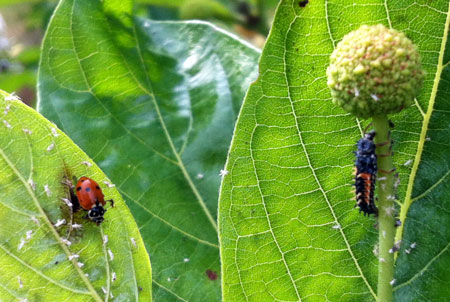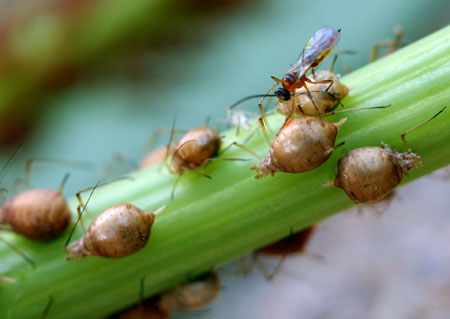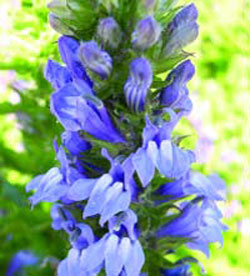Smart flower borders to attract beneficial insects
Attracting “good bugs” provides natural enemies for the “bad bugs” in your garden.
If you are looking for ways to outsmart the many insects that wreak havoc in your garden, consider planting flowers that attract beneficial insects. Start planning now to incorporate this Smart Gardening idea in your own garden. Every gardener can play a role in maintaining healthy populations of beneficial insects. By using this practice, you will enhance the biodiversity within your garden, thus working with nature and reducing the amount of money spent on pesticides.
What are beneficial insects? Not all bugs are bad. Bees and butterflies are needed to pollinate many crops. Some insects are natural enemies of other bugs; these are called predators or parasitoids. Predators eat other pest insects and help to naturally control these populations. For example, both the adult lady beetle and its larval stage are voracious consumers of aphids. Another beneficial insect, the syrphid fly’s larval stage has been known to consume 400 aphids during its development.

Adult lady beetle (left) and its larval stage (right) eating aphids on a button bush plant.
Photo credit: Rebecca Finneran, MSU Extension
Parasitoids use pest insects as their host; the adults lay their eggs within the host and once they hatch, they feed off of the pest insect and eventually kill it. Examples of parasitoids include braconid wasps that attack aphids, butterflies, sawflies, moths and beetles.

An example of a parasitic wasp that has formed aphid mummies on a cup plant; eventually an adult wasp will emerge from the mummy. Photo credit: Daniel Davis
What can you do?
Be aware that natural insect predators and parasitoids may already be in your garden. If you see insects, don’t assume that you need to get rid of them, but try to identify them and observe what’s going on. Planting specific flowers in your garden that supply beneficials with the shelter, nectar and pollen they require will help attract them.
Recommended plants often include non-native annuals such as buckwheat, sweet alyssum, dill and coriander. Consider using native plants as well; check out Michigan State University Extension’s “Attracting Beneficial Insects with Native Flowering Plants” for specific examples of flowers that attract natural enemies and bees. Sand coreopsis (Coreopsis lanceolata), yellow coneflower (Ratidbida pinnata) and blue lobelia (Lobelia siphilitica) showed best results in attracting natural enemies. Check out the Smart Gardening tip sheet titled “Going native can be a smart choice for Michigan landscapes” to find more information on this topic.

Blue lobelia (Lobelia siphilitica). Photo credit: Anna Fielder
Plan to intersperse these plants among your vegetables or plant a variety of them as borders next to your garden so they’re in close proximity to a source of food and shelter. Other methods include allowing cover crops or rape, kale, turnips and radishes to flower, hence providing insects with nectar and pollen. Use of ground covers and their selection based on the flowering time will also provide food for beneficials.
Home gardeners can encourage beneficial insects to their gardens in many ways. Through careful selection, planting and management, you too can attract these natural enemies to your garden!
Michigan State University Extension’s horticulture educators will be presenting Smart Gardening in a variety of ways at three public shows in Michigan during 2014. The Novi Cottage and Lakefront Living Show on Feb. 27-March 2; the West Michigan Home and Garden Show on March 6-9; and the Lansing Home and Garden Show on March 13-16 will host a variety of free seminars, informational booths and be the site to “ask the experts” from MSU Extension about your gardening questions.
For more information on a wide variety of Smart Gardening topics, visit the Gardening in Michigan website at www.migarden.msu.edu or contact MSU’s toll-free garden hotline at 1-888-678-3464.



 Print
Print Email
Email




